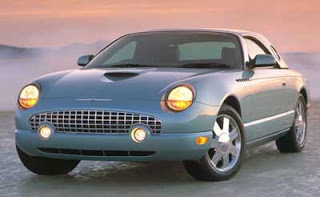The word "retro" derives from the Latin prefix retro, meaning "backwards" or "in past times" - particularly as seen in the words retrograde, implying a movement toward the past instead of a progress toward the future, and retrospective, referring to a nostalgic (or critical) eye toward the past.

Chrysler has sold over 1,000,000 retro-styled PT Cruisers
Over the last several years, the automobile industry has found success looking to the past. The PT Cruiser, Prowler, Chevrolet SSR, Mustang, Camaro, Challenger, T-bird and Beetle all look to past design trends with mostly positive results.
 It took three years to sell about 40,000 retro T-birds
It took three years to sell about 40,000 retro T-birds The New Beetle was launched in 1998
The New Beetle was launched in 1998
But like many things in the car business, what some people think is a new idea has already been tried... even retro. Some of my favorite examples are found on the cars of the 1955-1961 Forward Look era at Chrysler Corporation. Imagine creating a state of the art design - styling that would win Motor Trend Car of the Year for the entire corporate line up - while still incorporating motifs from 25 years in the past. The designers in Highland Park pulled it off!
 The Flite Sweep decklid was offered on many Chrysler products from 1957 - 1961
The Flite Sweep decklid was offered on many Chrysler products from 1957 - 1961  Retro free-standing headlamps were on 1961-63 Imperials
Retro free-standing headlamps were on 1961-63 Imperials
When Chrysler styling VP Virgil Exner started his own company with son Virgil Jr., one of their first projects was creating a modern look for the great classic marques of the 1930's. The results were published in the December 1963 Esquire magazine where readers were treated to contempary visions of a Stutz, Packard, Duesenberg and Mercer.
 Original illustration of the Esquire Duesenberg
Original illustration of the Esquire DuesenbergThis "retro" exercise led to a number of projects for the Exners. The Mercer design was used to build the Mercer Cobra show car for the Copper Development Association. The Duesenberg illustration convinced investors that Exner was the right choice for designing their revival attempt of the classic luxury car. The Renwal model company made a very sucessful line of 1/25th scale model cars with the Exners. Virgil Sr. even had a retro Bugatti made for himself and later designed the 1970 Stutz Blackhawk.
 Copper Development Association's Mercer Cobra
Copper Development Association's Mercer Cobra

1966 Duesenberg

One of 7 Revival models made by Renwal

Virgil Exner's Bugatti 101C
 1971 Stutz sales photo
1971 Stutz sales photo
Although retro styling can have mass market appeal or help a wealthy few stand out from the crowd, it can evetually lead to a dead end. How do you move forward while still looking back?

 It took three years to sell about 40,000 retro T-birds
It took three years to sell about 40,000 retro T-birds The New Beetle was launched in 1998
The New Beetle was launched in 1998 The Flite Sweep decklid was offered on many Chrysler products from 1957 - 1961
The Flite Sweep decklid was offered on many Chrysler products from 1957 - 1961  Retro free-standing headlamps were on 1961-63 Imperials
Retro free-standing headlamps were on 1961-63 Imperials Original illustration of the Esquire Duesenberg
Original illustration of the Esquire Duesenberg Copper Development Association's Mercer Cobra
Copper Development Association's Mercer Cobra 





 Syd Mead - Fender Blended Sports Car
Syd Mead - Fender Blended Sports Car